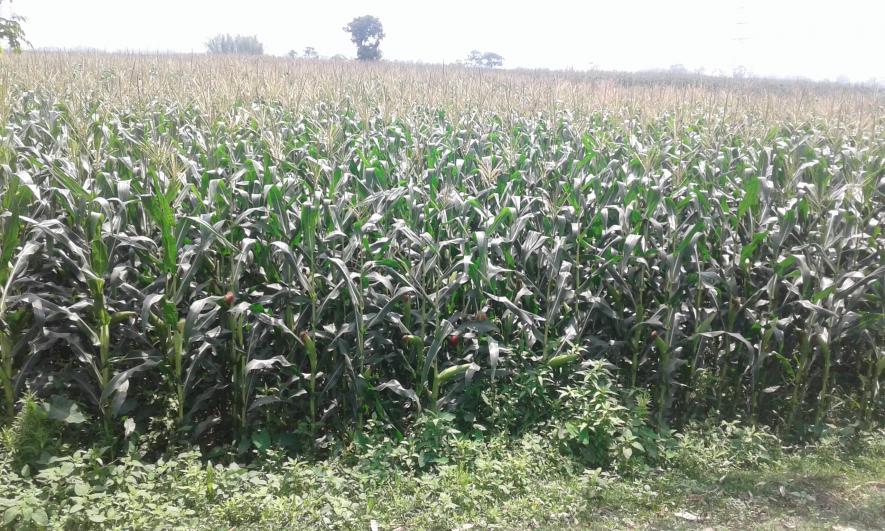Maize-Growing Farmers In Bihar Upset Over Dismal Prices

Images: Mohd Imran Khan
Kishanganj/Purnea (Bihar): Dularchand Mahto is a worried farmer in the maize and corn hub of Seemanchal region in Bihar, because he fears he may not get the right price for his maize crop yet again. He says that middlemen and traders exploit farmers and the lack of government support.
“We opted to grow maize in place of jute a few years ago, as it is a cash crop and high in demand, but thanks to middlemen, traders and government’s failure in fulfilling its promises, farmers like me are not getting any returns,” said Mahto, a small farmer living at Motihara village in Kishanganj district.
Mahto is one among thousands of maize-growing farmers who are unhappy in Seemanchal.
“Exactly five years ago, Modi during the election campaign had promised to provide the right MSP for maize crop. If the Modi government had fulfilled the promises it made to us, our condition today would have been better, but it has only gotten worse,” Mahto told Newsclick.
Seemanchal consists of Kishanganj, Araria, Purnea and Katihar districts, all of them poor and backward. As per government data, maize is grown on about 1,40,000 hectares. In the neighbouring region of Koshi, consisting of Madhepura, Saharsa and Supaul districts, maize is grown on about 60,000 hectares.
More than 17 lakh MT of maize is grown annually in Seemanchal and Koshi. Of this, more than 14 lakh MT is purchased by big traders and MNCs and sent outside while around 3 lakh MT is consumed locally.
According to state agriculture department officials, nearly 65 per cent of the total maize in Bihar is grown in Seemanchal and Koshi regions alone. “Maize is mainly grown in four Seemanchal districts. Most of the farm lands are full of green, standing maize crops along the national highways and state highways passing through these districts.”
Also read: Elections 2019: Bihar’s Biggest Grain Market Has no Toilet or Drinking Water
Bihar is India’s third largest producer of maize. The rabi-sown maize with higher yields has increasingly replaced winter wheat and paddy in large parts of the state over the past decade or so.
Though officially the maize price has risen from Rs 1,050 in 2015 to Rs 1,700 in 2018, but most maize-growing farmers continue getting less than the rate that was fixed by the government.
Mahto’s sentiments are echoed by Mohd Akil, another marginal maize growing farmer in Dhumania village of the district.
“I got Rs 800 per quintal for maize last year because as a poor farmer we need money immediately after harvest, unlike big and rich farmers who have the facility to store their produce and get a good price later. Middlemen and local traders exploit us and the government hardly helps us,” said Akil.
There are farmers who got Rs 950 to Rs 1,000 to even Rs 1,050 per quintal for their maize.
Akil said Modi during his campaign in Seemanchal in 2014 had declared the region as a maize hub and had promised to help the farmers if his government came to power.
“Modi has been in power for 5 years, but he forgot about us. We are still struggling to get rid of the middlemen and traders and to get the right price.”
Sukhdeo Yadav, a maize grower in Chandragaon village under Baisi block of Purnea district, has a similar story to share.
“We are not getting the correct price for maize because middlemen and traders rule the roost here, they enjoy the fruit of our hard labour in growing the crop.”
He added, “We get hardly Rs 800 to 1,000 per quintal of maize. But middle men and traders sell maize at Rs 1,400 to 1,600 per quintal. It is they who earn the maximum profit from our maize.”
But a big farmer like Mirtunjay Bhardawaj, who owns 30 bighas of land in a village in Kishanganj, said he had no problem getting a good price for his maize.”
“I usually sell 3 to 4 months after harvest. But small and marginal farmers are forced to sell maize in distress.”
In Purnea’s Gulab Bagh grain market, the centre for selling of the maize or corn grown in Seemanchal, a big trader dealing with maize told Newsclick that farmers were growing maize as they can get money immediately, unlike with other crops, but they still end up earning less than what traders get.
“There is no doubt that they grow the maize while we make the money out of it by selling it to national and international companies.”
Also read: Election 2019: Poverty, Unemployment and Migration Haunt Muslim-dominated Kishanganj
Another maize trader at Gulag Bagh, Mohit Kumar, said most of the maize grown in Seemanchal was exported to Indonesia, Malaysia, Vietnam, etc.
“Top brand names including international traders have been purchasing maize from Seemanchal, as it is cheap and easily available.”
As these farmers of Seemanchal go for polling in the constituencies of Kishanganj, Purnea and Katihar on April 18 under the second phase of the elections (Bhagalpur and Banka seats are also going to polls), they will cast their vote with the Modi government’s unfulfilled promises in mind.
Get the latest reports & analysis with people's perspective on Protests, movements & deep analytical videos, discussions of the current affairs in your Telegram app. Subscribe to NewsClick's Telegram channel & get Real-Time updates on stories, as they get published on our website.























